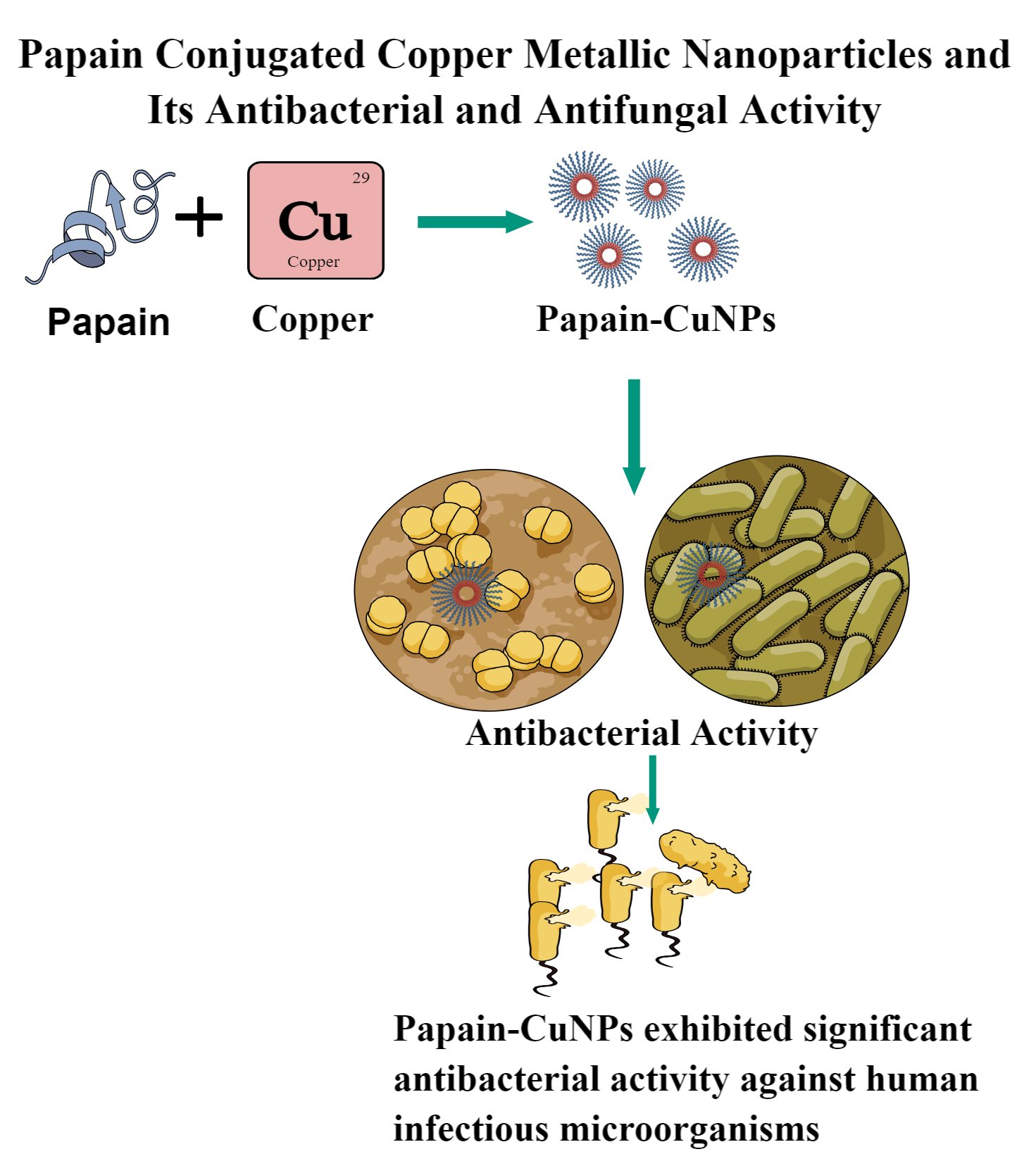Sat, Jul 26, 2025
[Archive]
Volume 21, Issue 3 (September 2024)
IJMSE 2024, 21(3): 125-134 |
Back to browse issues page
Download citation:
BibTeX | RIS | EndNote | Medlars | ProCite | Reference Manager | RefWorks
Send citation to:



BibTeX | RIS | EndNote | Medlars | ProCite | Reference Manager | RefWorks
Send citation to:
Kotakonda M, V.S S, G A, Pakkiyan S N, Alungal N A, K M K, et al et al et al et al . Biogenic Synthesis of Papain Conjugated Copper Metallic Nanoparticles and Its Antibacterial and Antifungal Activity. IJMSE 2024; 21 (3) :125-134
URL: http://ijmse.iust.ac.ir/article-1-3547-en.html
URL: http://ijmse.iust.ac.ir/article-1-3547-en.html
Muddukrishnaiah Kotakonda 
 , Sajisha V.S
, Sajisha V.S 
 , Aiswarya G
, Aiswarya G 
 , Safeela Nasrin Pakkiyan
, Safeela Nasrin Pakkiyan 
 , Najamol A Alungal
, Najamol A Alungal 
 , Mayoora Kiliyankandi K
, Mayoora Kiliyankandi K 
 , Divya Thekke Kareth
, Divya Thekke Kareth 
 , Naheeda Ashraf Verali Parambil
, Naheeda Ashraf Verali Parambil 
 , Saranya Sasi Mohan
, Saranya Sasi Mohan 
 , Renjini Anil Sheeba
, Renjini Anil Sheeba 
 , Sarika Puthiya Veettil
, Sarika Puthiya Veettil 
 , Dhanish Joseph
, Dhanish Joseph 
 , Nishad Kakkattummal
, Nishad Kakkattummal 
 , Afsal Bin Haleem MP
, Afsal Bin Haleem MP 
 , Safeera Mayyeri
, Safeera Mayyeri 
 , Thasneem Chemban Koyilott
, Thasneem Chemban Koyilott 
 , Nasiya Nalakath
, Nasiya Nalakath 
 , Samuel Thavamani B
, Samuel Thavamani B 
 , Famila Rani J
, Famila Rani J 
 , Aruna Periyasamy
, Aruna Periyasamy 
 , Chellappa V Rajesh
, Chellappa V Rajesh 
 , Rameswari Shanmugam
, Rameswari Shanmugam 
 , Marimuthu Poornima
, Marimuthu Poornima 
 , Tina Raju
, Tina Raju 
 , Roshni E R
, Roshni E R 
 , Sirajudheen Mukriyan Kallungal
, Sirajudheen Mukriyan Kallungal 
 , Lekshmi MS Panicker
, Lekshmi MS Panicker 
 , Saranya K G
, Saranya K G 
 , Shilpa V P
, Shilpa V P 


 , Sajisha V.S
, Sajisha V.S 
 , Aiswarya G
, Aiswarya G 
 , Safeela Nasrin Pakkiyan
, Safeela Nasrin Pakkiyan 
 , Najamol A Alungal
, Najamol A Alungal 
 , Mayoora Kiliyankandi K
, Mayoora Kiliyankandi K 
 , Divya Thekke Kareth
, Divya Thekke Kareth 
 , Naheeda Ashraf Verali Parambil
, Naheeda Ashraf Verali Parambil 
 , Saranya Sasi Mohan
, Saranya Sasi Mohan 
 , Renjini Anil Sheeba
, Renjini Anil Sheeba 
 , Sarika Puthiya Veettil
, Sarika Puthiya Veettil 
 , Dhanish Joseph
, Dhanish Joseph 
 , Nishad Kakkattummal
, Nishad Kakkattummal 
 , Afsal Bin Haleem MP
, Afsal Bin Haleem MP 
 , Safeera Mayyeri
, Safeera Mayyeri 
 , Thasneem Chemban Koyilott
, Thasneem Chemban Koyilott 
 , Nasiya Nalakath
, Nasiya Nalakath 
 , Samuel Thavamani B
, Samuel Thavamani B 
 , Famila Rani J
, Famila Rani J 
 , Aruna Periyasamy
, Aruna Periyasamy 
 , Chellappa V Rajesh
, Chellappa V Rajesh 
 , Rameswari Shanmugam
, Rameswari Shanmugam 
 , Marimuthu Poornima
, Marimuthu Poornima 
 , Tina Raju
, Tina Raju 
 , Roshni E R
, Roshni E R 
 , Sirajudheen Mukriyan Kallungal
, Sirajudheen Mukriyan Kallungal 
 , Lekshmi MS Panicker
, Lekshmi MS Panicker 
 , Saranya K G
, Saranya K G 
 , Shilpa V P
, Shilpa V P 

Abstract: (16086 Views)
Biogenic synthesis of papain-conjugated copper metallic Nanoparticles and their antibacterial and antifungal activities Papain metallic conjugated nanoparticles (Papain-CuNPs) were synthesised using Papain and CuSO4.5H2O. Papain-CuNPs were characterized using UV-visible spectroscopy, FT-IR, HR-TEM, XRD, FE-SEM, zeta potential, and a zeta sizer. The antibacterial activity of papain-CuNPs against human infectious microorganisms (Citrobacter spp, Pseudomonas aeruginosa and Candida albicans) was investigated. The mechanism of action of papain-CuNPs was evaluated using FE-SEM and HRTM. UV spectroscopy confirmed the plasma resonance (SPR) at 679 nm, which indicated the formation of papain-CuNPs. The FT-IR spectrum absorbance peaks at 3927, 3865, 3842, 3363, 2978, and 2900 cm-1 indicate the presence of O-H and N-H of the secondary amine, and peaks at 1643 and 1572 cm-1 represent C=O functional groups in Papain-CuNPs. EDAX analysis confirmed the presence of copper in the papain-CuNPs. The zeta potential (-42.6 mV) and zeta size (99.66 d. nm) confirmed the stability and size of the nanoparticles. XRD confirmed the crystalline nature of the papain-CuNPs. FE-SEM and HRTM showed an oval structure, and the nano particles' 16.71244–34.84793 nm. The synthesized papain-NPs showed significant antibacterial activity against clinical P. aeruginosa (15 mm). MIC 125 µg/ml) showed bactericidal activity against P. aeruginosa and the mechanism of action of Papain-NPs was confirmed using an electron microscope by observing cell damage and cell shrinking. Papain-CuNPs have significant antibacterial activity and are thus used in the treatment of P. aeruginosa infections
Type of Study: Research Paper |
Send email to the article author
| Rights and permissions | |
 |
This work is licensed under a Creative Commons Attribution-NonCommercial 4.0 International License. |






